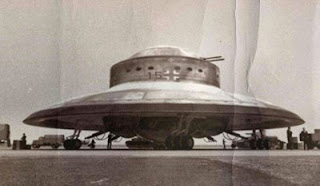The saucer-shape of German spacecraft, employing a radically different design paradigm than the vessels of other nations, suggests a source of technological information separate from the captured resources of the failed “Martian” invasion of 1898. The preponderance of evidence suggests this knowledge was shared with certain occult societies that support the Nazi Party by a more advanced race--the beings referred to in intelligence reports as the “Blond” or “Nordic” adepts.
Captured documents refer to these beings as “Hyperborean.” It is the belief of the Thule Society and other German occult groups they are the pure-blooded descendants of the original “Aryan” race they once lived in a polar Atlantis. Some cataclysm led to their empire’s collapse and they retreat to a hidden redoubt. This is variously described as “underground” or within the “hollow earth.” The name Agartha is often used for this enclave.
The Agarthans or Hyperboreans are associated with a symbol called the “Black Sun.” Psychometric intelligence gives the impression that their civilization may be nourished by a literal black sun--some sort of sphere of concentrated vril energy.
If the Hyperboreans are of terrestrial origin, it raises the question as to where they have been throughout recorded human history. Their attractive forms and metaphysical powers suggest the possibility that encounters with these beings may underlie much of human mythology and folklore.
Hyperboreans are physically and psychically stronger than normal humans. Extreme caution should be taken when encountering them either physically or astrally.
(More from an alternate Spelljammer Pulpier Space.)
2 hours ago



























